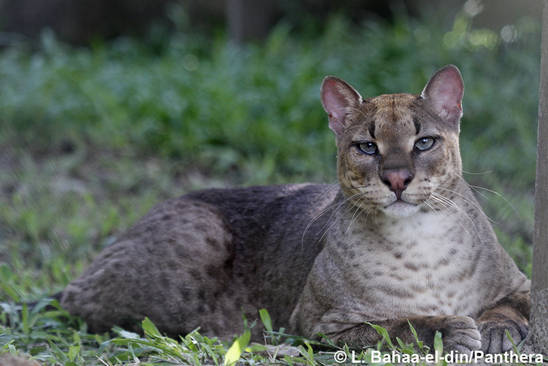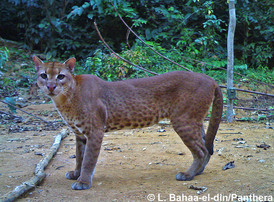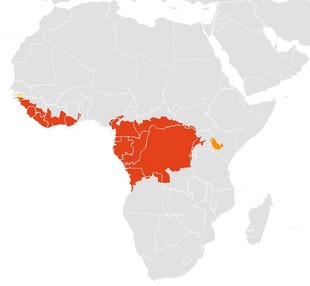African golden cat
Caracal aurata
IUCN Red List: Vulnerable
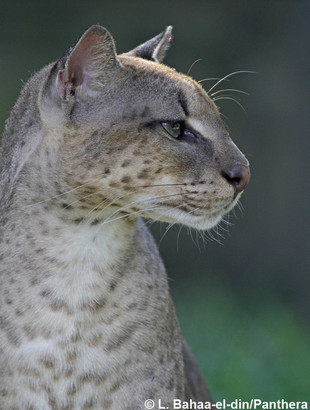
| Weight: | 7-16 kg |
| Body length: | 65-90 cm |
| Tail length: | 28-35 cm |
| Longevity: | to 12 years |
| Litter size: | 1-2 cubs |
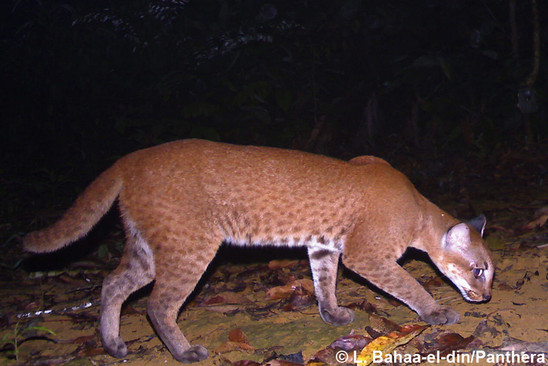
Description
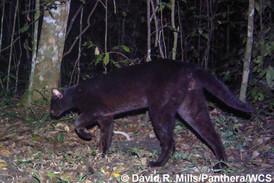
- Melanistic golden cat, Maramagombo Forest, Uganda
The African golden cat (Caracal aurata) has traditionally been included in the genus Felis or Profelis. More recent molecular analysis has shown that the African golden cat is most closely related to the caracal (Caracal caracal) and the serval (Leptailurus serval). It is classified in the genus Caracal.
Based on biogeographical patterns among other rainforest species, there are possibly two subspecies of the African golden cat:
- Caracal aurata aurata in East and Central Africa as far west as the River Congo and
- Caracal aurata celidogaster in West Africa, west of the River Congo
However, a molecular study is required to confirm this subspecies division and to clarify if a wide area of intergradiation of the two subspecies exists in Central Africa.
The African golden cat is a medium-sized, compactly built cat with relatively short legs. Its head is small relative to its body and its ears are rounded and untufted. The fur pattern of the African golden cat can vary significantly within and between regions. The fur colour can be reddish-brown or greyish and can be spotted or plain. The throat, chest and underside are white, and there are generally large dark spots on the belly. African golden cats have white patches around the eyes and on their cheeks. Golden cats east of the river Congo tend to have few markings whereas in West Africa, they tend to be more spotted. In areas where melanistic golden cats have been recorded, they occur at a rate of about 5% of all individuals. The tail of the African golden cat is approximately one third of its head-body length.
Despite the close resemblance of the African golden cat to the Asiatic golden cat, they are not closely related. Convergent evolution of the two species, due to them occurring in similar habitat, is considered as the likely cause of this resemblance as there has been no direct forest connection between Africa and Asia for 20 million years.
Language/Country | Name |
|---|---|
Democratic Repubilc of the Congo (Mbuti Pygmies) | Osolimi, makolili, akalwa, egabosoti, esele, a'ka |
East Africa (Lukiga; Lukonja; Kipsigi) | Embaka; ekinyange; semaguruet |
French | chat doré africain |
Gabon (Kota; Fang; Kwele) | lobwa; ebyo; ebie |
German | Afrikanische Goldkatze |
Mandinka | Soukalan |
Peul | donnou, dondou |
Spanish | gato dorado |
West Africa (Lingala) | gnaou ya zamba |
Status and Distribution
The African golden cat is listed as Vulnerable on the IUCN Red List. In the National Red List of Uganda, the species is listed as Endangered. It is poorly known and only very rarely observed in the wild. This is largely due to the moist forest habitat in which it lives and its shy nature which have made it difficult to study. Evaluating its conservation status has thus far been challenging due to the resulting lack of information on its biology and ecology. Most information comes from a few dietary studies and museum specimens. The African golden cat is generally considered as rare and no reliable density estimates exist.
The African golden cat is endemic to the African tropical forest and occurs throughout equatorial Africa, from Senegal throughout the Congo Basin over to Uganda. However, there are no confirmed records from The Gambia, Togo or Benin. This indicates a possible separation of African golden cat populations between Western and Central Africa. In Kenya, a dead African golden cat was found in 2019 next to a road, which is the first confirmed record since 1946 from that country.
In Gabon, density estimates ranged from 3.8 individuals per 100 km² in a site with subsistence bushmeat hunting to 10.2–12.8 per 100 km² in two logging concessions and 16.2 per 100 km² in a protected area.
Habitat
The African golden cat is a forest-dependent species and is strongly associated with moist forest habitats. It favours primarily equatorial forests with little human disturbance. Nevertheless, it seems to be quite adaptable and also occurs in montane, bamboo and secondary forests as well as in coastal forest habitat and wooded savannahs.
The African golden cat apparently adapts well to sustainably logged areas, perhaps due to the resulting dense secondary undergrowth that produces high rodent abundance. The periphery of the African golden cat’s range stretches into savannah regions bordering forests associated with river drainages. The golden cat has been recorded at elevations up to 3,600 m in Uganda.

Ecology and Behaviour
Biology, distribution and social structure of the African golden cat are largely unknown and the information available comes from a few observations. Although the species has been known for almost 200 years, the first live individual was pictured in the wild in Gabon in 2002. In 2008, an African golden cat was pictured in the Kibale National Park of Uganda and in 2009 an individual was seen catching a small mammal on a road in Bwindi Impenetrable National Park in Uganda. Since 2010, golden cats have been captured hundreds of times by camera traps in studies in Gabon and Uganda. These studies confirm the species to be solitary. Competition or predation by leopards (Panthera pardus) may also negatively impact the African golden cat. It sometimes gets killed by leopards and both species seem to take similar prey species. There are indications that the African golden cat’s activity pattern is dependent on its surroundings: golden cat activity was cathemeral (active at any time of day and night) in the presence of largely nocturnal leopards, but mostly nocturne-crepuscular in areas where leopards are absent. However, as leopard absence was concurrent with and probably caused by high human pressure, it was impossible to determine whether the change was a response directly to the increased human activity, or indirectly to the absence of the apex predator.
Little is known about the African golden cat’s hunting behaviour. It probably hunts most of its prey on the ground but may also hunt in trees to some extent. Very little is known about its reproductive biology. The only data comes from a captive pair from the 1970s, which produced a total of 4 litters with 2 kittens per litter. Only one of these 4 reproductions was documented in detail, with gestation lasting 75 days.
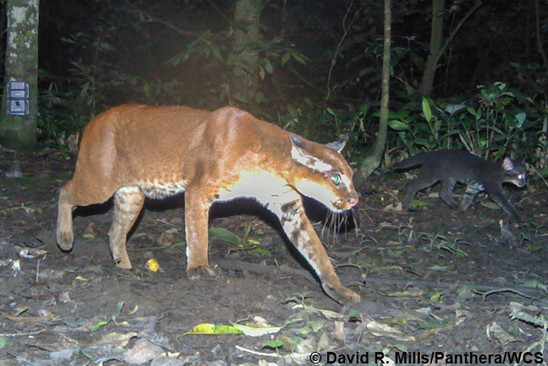
Prey
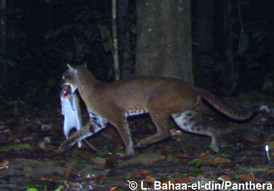
- An African golden cat with its prey.
In studies of African golden cat scats in the Congo and the Central African Republic, rodents (such as squirrels) and small duikers made up the majority of its prey items. Apparently it also preys on birds, hyraxes, bats and primates. There is a record from western Uganda of a golden cat killing a red colobus monkey and of an individual stalking a Talapoin monkey on the ground at night in Gabon. In the Ivory Coast’s Tai National Park, remains of pangolins were frequently found in the scats of African golden cats. The mean weight of the African golden cat’s prey was estimated in a study of the Democratic Republic of Congo to be 1.4 kg. In a study in the Central African Republic, mean prey weight was 3.6 kg, but with 52% of prey items weighing less than 1 kg. Predation on domestic livestock such as chickens, goats and sheep, has been recorded but appears to be rather rare.
Main Threats

- Animals killed for the bushmeat trade.
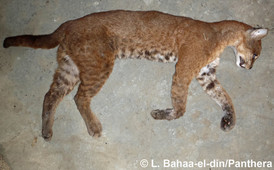
- African golden cat killed by a snare.

- African golden cat, which lost its left hindpaw because of a snare.
The main threat to the forest-dependent African golden cat is habitat loss and fragmentation through deforestation which leads to a patchy habitat structure, especially in Eastern and Western Africa. The African golden cat has already lost about 44% of its former known range. Infrastructure development and human population growth within the species range are of high concern. Road construction increased rapidly in the past 15 years as for example in the Democratic Republic of Congo and in the Congo. Bushmeat hunting is another major problem posing a two-fold threat to African golden cats: direct mortality through captures in cable snares and through depleting of their prey species. In areas with suitable habitat but with heavy human hunting pressure, as in Dibouka village (Gabon) or Korup National Park (Cameroon), the African golden cat has not been recorded. In mainland Equatorial Guinea, the African golden cat was found to occupy only 16% of the 78% of putatively suitable habitat of Rio Muni. The impact of the hunting and trading of the African golden cat is not clear but it could be a significant threat. Although the African golden cat is often not the target species, if it is captured, it is consumed and its fur is used or sold maybe for ritual purposes, to wrap things up (parts of the African golden cat’s skin have totemic value) or as good luck charms for hunting success.
Though predation of livestock by African golden cats appears rare, they may be perceived as a threat to livestock and killed in areas near human settlements.
Conservation Efforts and Protection Status
The African golden cat is included in Appendix II of CITES. It is only fully protected over part of its range. Hunting is prohibited in Angola, Benin, Burkina Faso, Congo, Ghana, Ivory Coast, Kenya, Liberia, Nigeria, Rwanda, Sierra Leone and Democratic Republic of Congo. Hunting is regulated in Gabon, Liberia and Togo. The African golden cat is not legally protected in Cameroon, Central African Republic, Gambia, Guinea Bissau, Senegal, Tanzania and Uganda and domestic trade is not controlled in Congo and Sierra Leone. No information is available from Burundi and Guinea.
How much the African golden cat can adapt to changing habitat conditions and what current levels of threat are in place cannot be answered due to a lack of information. However, recent studies found newly logged concessions to be important habitat for golden cats, and should thus be incorporated within the conservation estate.
There is an urgent need for further research on the African golden cat’s distribution, density in various habitats and general status. More information about its ecology, demography and behaviour are also very important in order to get a detailed understanding about the essential characteristics and needs of this species. This is fundamental for its status evaluation and for planning and implementing appropriate conservation measures.
